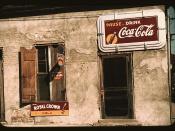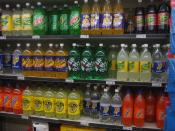TROY'S ASSIGNMENT
Index
page
1 Cover page
2 Index page
3-8 Part 1 - The macroenvironment
8-14 Part 2 - The marketing mix
15 Bibliography
INTRODUCTION
Within this report the macro-forces of an industry will be analysed, continuing on to compare
the marketing mix of two organisations within that industry. All organisations - with their
suppliers, customers, competitors, and publics - have a macroenvironment. This environment
consists of macro forces that act on and affect the organisation and are generally outside their
control, as opposed to the micro forces which also affect the organisation, but are generally
under their control. The marketing mix is the term used to describe how an organisation goes
about developing a product and selling it to the market.
The industry chosen is soft drinks which industry falls into the category of fast-movingconsumable-
goods (FMCG's), as it is a product that is consumed, and is fast-moving.
These
won't sit in a supermarket or convenient store for long, as they are constantly being
purchased. Other examples of a 'FMCG' are canned foods, ice cream, soup, cereal, potato
chips and a whole lot more.
PART 1
There are six main macro forces making up the "macroenvironment." These are:
÷ The demographic environment - which is the study of human populations in terms of size,
density, location, age, sex, race, and occupation1. Studies in this area, for example, can
show the changing age structure, which is necessary, as marketeers need to understand
who makes up the market, thus allowing them to make the most effective decisions for the
marketing mix.
÷ The economic environment - which has an effect on consumer purchasing power and
spending. For example, if the average income drops, then there is likely to be less buying
power2.
÷ The natural environment - involves natural resources...


